I was recently given the opportunity to work as a Collections Care Intern at the Smithsonian Institution Archives for the months of November and December 2015, under the supervision and partnership of the Archives’ Collections Care Team. During my short time here, I worked on two parallel projects focused on surveying, preserving, and treating oversized archival collections: one here at the Archives, and the other at the Smithsonian’s National Museum of Natural History.
Smithsonian Institution Archives
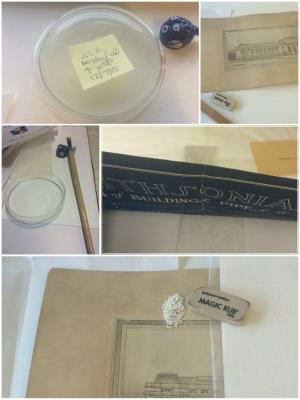 The oversized collections that I worked with at the Archives mainly consisted of architectural drawings, reproductions, and photographs, though there were also panoramic photos, maps, and drawings present. The storage and conditions these objects are housed in are designed for long term storage, prioritizing preservation and stability. All are stored flat in archival folders within metal drawers. The standard drawer size for oversized materials is 1.75”h x 50”w x 38.5”d, although we have a limited number of larger drawers. There were relatively few preservation issues in this collection (or at least the small percentage of the collection that I saw). The most common ones I came across included documents sustaining damage from being stored in folders that were too small or being attached with staples, tape, or paperclips; as well as rips, tears, and varying levels of grime. These were flagged for future treatment, though I did get to perform some surface cleaning and mending on a few of them.
The oversized collections that I worked with at the Archives mainly consisted of architectural drawings, reproductions, and photographs, though there were also panoramic photos, maps, and drawings present. The storage and conditions these objects are housed in are designed for long term storage, prioritizing preservation and stability. All are stored flat in archival folders within metal drawers. The standard drawer size for oversized materials is 1.75”h x 50”w x 38.5”d, although we have a limited number of larger drawers. There were relatively few preservation issues in this collection (or at least the small percentage of the collection that I saw). The most common ones I came across included documents sustaining damage from being stored in folders that were too small or being attached with staples, tape, or paperclips; as well as rips, tears, and varying levels of grime. These were flagged for future treatment, though I did get to perform some surface cleaning and mending on a few of them.
One of the main goals of the survey I performed was to find solutions to maximize the space within these metal drawers without compromising the quality of storage. This meant making sure that all of the objects were in the smallest size folder that could contain them, and arranging them in the drawers in a systematic manner. Proposed drawer divisions were drawn up to reflect this format using standard size folders, and during the survey, items that could be rehoused were noted. Though it may not seem like it, rehousing these documents in appropriately sized folders and reorganizing the drawers cuts the space needed to store them by a significant margin. When you are working on a collection as large in size as the one that is housed here, space is a precious commodity.
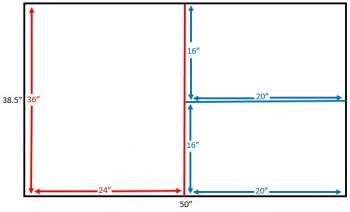
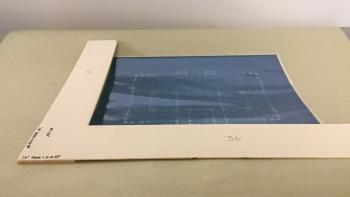
National Museum of Natural History
While I was working on the collections at the Archives, I also assisted with a similar project in the Smithsonian’s National Museum of Natural History’s maps collection. These are maps collected by Smithsonian researchers for planning and during their expeditions on behalf of the Institution, and are considered Associated Collection Assets. With a history of diverse storage and access among the many units at NMMH, recent efforts have made great progress to catalog, digitize, and provide unified storage locations for them. While great gains have been made by the collection manager and a team of dedicated volunteers to adopt flat files, locate and manage the maps in a consistent way, due to limited resources for this non-accessioned collection, there remains lots of room for improvement.
Proper storage is important to avoid inducing or worsening extant damage. Many of these drawers appeared to be overstuffed with little or no protective housing around any of the maps, and the usual vinyl dust covers found in standard flat files are degrading. Small but bulky items were bundled together in the drawer with elastic bands, which are not recommended for use in archival situations, as they degrade rapidly and pop off, causing disorder, and worse, stick to and stain adjacent objects.
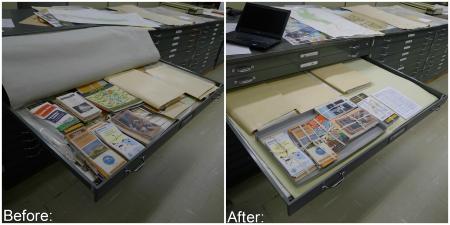 Our main goal with these collections was to find storage solutions that were inexpensive and easy to incorporate. Introducing a variety of sizes of sturdy archival folders as a storage technique to group bundles of items, divided at sensible points by their catalog and/or size, for all of the items in a drawer was one such solution. It resulted in the items being protected within the drawers, and increased the ease of organization and handling of the oversized items. Elastic bands were replaced with cotton ties (loosely tied with the library knot, also known as an herbarium knot), and (similar to the storage solution at the Archives) drawer divisions were proposed using standard sized folders, and trays to hold the smaller and folded maps, which help to lift the smaller items at once to access folders beneath, increasing efficiency and reducing handling and loss to the back of the drawer.
Our main goal with these collections was to find storage solutions that were inexpensive and easy to incorporate. Introducing a variety of sizes of sturdy archival folders as a storage technique to group bundles of items, divided at sensible points by their catalog and/or size, for all of the items in a drawer was one such solution. It resulted in the items being protected within the drawers, and increased the ease of organization and handling of the oversized items. Elastic bands were replaced with cotton ties (loosely tied with the library knot, also known as an herbarium knot), and (similar to the storage solution at the Archives) drawer divisions were proposed using standard sized folders, and trays to hold the smaller and folded maps, which help to lift the smaller items at once to access folders beneath, increasing efficiency and reducing handling and loss to the back of the drawer.
Lastly, we held a mini-workshop on mending techniques for torn maps, improving technique which assists the volunteers to prepare vulnerable maps for safer scanning.
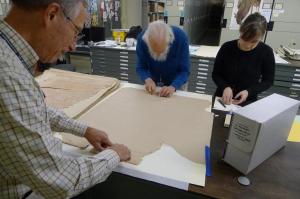
Related Resources
Maps Catalog, National Museum of Natural History
The Squeaky Wheel Gets the Grease: A Custom Storage Solution for an Unusual Collection, The Bigger Picture Blog, Smithosnian Institution Archives
Panoramic Panic Part III, The Bigger Picture Blog, Smithosnian Institution Archives
Produced by the Smithsonian Institution Archives. For copyright questions, please see the Terms of Use.

Leave a Comment